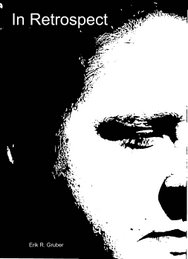
I was born an avid outdoorsman. I loved the tall, statuesque trees, the smell of pollinating wildflowers, the buzz of cicadas in the distance. All of this represented the mysterious unknown, the unencumbered wild, the adventures and trials and dangers that must be encountered to become a man.
My dad also loved the outdoors. He had already become a man, but appreciated the wisdom those tall old trees held, welcomed the simplistic splendor of a bumble bee on a marigold, and recognized in my eyes the mystery and dangers that wilderness offered growing boys.
Growing up, I lived less than a mile away from a small wilderness area known as Brookdale Park. This park provides the usual amenities that recreational facilities do; baseball diamonds, playground, warming house, skating rink, basketball hoops. Of more interest to me, however, was the bike trail that circled around a small pond. This pond fascinated me. Small creek running in, small creek running out, lilly pads, turtles, ducks, deer, frogs, snakes, fish, an occasional blue heron, crayfish, leeches, eagles, all contained by a silent sentinel, an unwavering, constant reminder that this pond did not belong to cyclists and walkers, but belonged to the forest, and there was no entry for those who passed by: the cattails.
There are two types of cattail commonly found in North America. Typha latifoia, or broad-leaved cattail, was first discovered in North America in 1836, and is a native plant. Typha angustifolia, or narrow-leaved cattail, was originally split into two sub-groups – a native species labeled Typha gracilis and a European species named Typha angustifolia. In the 1850’s the two were merged into one group, adopting the name Typha angustifolia, and botanists have since denied the possibility of a native species and a foreign species coexisting. They believe it was actually one species all along, but had been misidentified. Whether narrow-leaved cattail is a foreign or native species is still under much dispute.
As my dad and I would roll our bikes through this modest preserve we would make frequent pit stops, abandoning our transportation on the paved path in search of solitude and maybe a little adventure closer to the water. It is strange how pavement blinds us to the natural world. How often do we drive through a small, surviving patch of wilderness, sheer speed making it virtually invisible? I blame it on the pavement, the roads. Roads pass through in straight lines, they move from the starting point to the destination as quickly as possible. They make no tangents, they do not lollygag. Beginning. End.
Life should not be so linear. The earliest American tribes saw time as circular. There was no beginning and end, just a cycle of life. Old things would cease, new things would emerge, but in time the old things would return and the new things would disappear. Travel was intended to be this cyclical. Through nature there is seldom a straight path. We must swerve and climb and leap and duck, and in the end would it be so bad to return to the place that we began? Maybe that’s where we’re supposed to be.
Cattails force departure from the world of pavement to the world of wilderness. To see beyond them one must join them, tromp amongst them, and physically move them to the side. This is exactly what my dad and I set out to do when we strayed from the path. By taking our place amongst those flourishing plants we could see beyond to the pond they contained. We could see the turtles sitting on logs, taking in the midday sun to warm their cold-blooded bodies. We could see an occasional bass rise to the surface to snatch a slow-moving bug. We could see a mother duck with her new hatchlings, swimming perfectly in sync, all in line to avoid getting lost. We could see the Great Blue Heron standing along the shoreline, soaking its feet in the cool water.
I find it interesting that the origin of cattails is the subject of so much controversy. Maybe it is because nobody ever really stops to pay attention to them. They impede our view to the water, where the wilderness is, but are so seldom appreciated for the vital role they play in that very wildness which we find so endearing. They provide food and shelter to many species of fish, insects, and birds. They provide wintertime cover for white-tailed deer and ring-necked pheasants, helping an increased number of these animals survive the cold. They produce oxygen, absorb some of the chemicals that drain into the lake during rainfall, and protect the shoreline from the erosion that waves cause. Yet the cattails are not elegant, they do not bloom like the wildflowers or soar like the herons. They are not cute like the infant ducks. They are not ferocious like the hawks, majestic like the deer, mysterious like the foxes. They are overlooked, ignored, misidentified and undervalued.
For much of my life I held this same mindset. The cattails, for me, were always a nuisance. In my youth I would take great joy in clutching these plants at their roots and tearing them from the earth in a simultaneously impulsive and pre-meditated act. They blocked my view to the water, to the wilderness beyond, and were better put to use as sibling pokers than as members of the natural landscape. My dad would always scold me for such destructive behavior: “Why do you tear down the cattails?” I did not understand why he came to their defense. “Because they’re no good where they are.” I see now what he saw then, and have come to appreciate his wisdom. “Maybe they’re exactly where they’re supposed to be. You think they were put there to block us out, I say they were put there to invite us in. They contain and protect the wilderness we love so much. Think like a cattail.”
It has taken me years to figure out what he was talking about. The cattails truly know how to cherish nature, and it would be beneficial to take a lesson from them. They silently observe, but are still involved. They keep the bad out, and keep the good in. They force us to crawl amongst them, come face to face with wilderness, become a part of the Creation, and only then will they unveil the beauty and majesty that lies beyond. We were put on this earth to observe the Creation and to care for the Creation and to become one with the Creation. In order to truly love nature we must become a part of it. We must stand as one of the cattails.
Thanks for reading.
 On Tuesday, the much anticipated third installment of the Halo series was released for XBOX 360. I’m here to offer some initial reactions.
On Tuesday, the much anticipated third installment of the Halo series was released for XBOX 360. I’m here to offer some initial reactions.





































